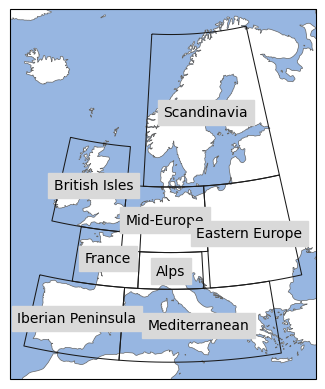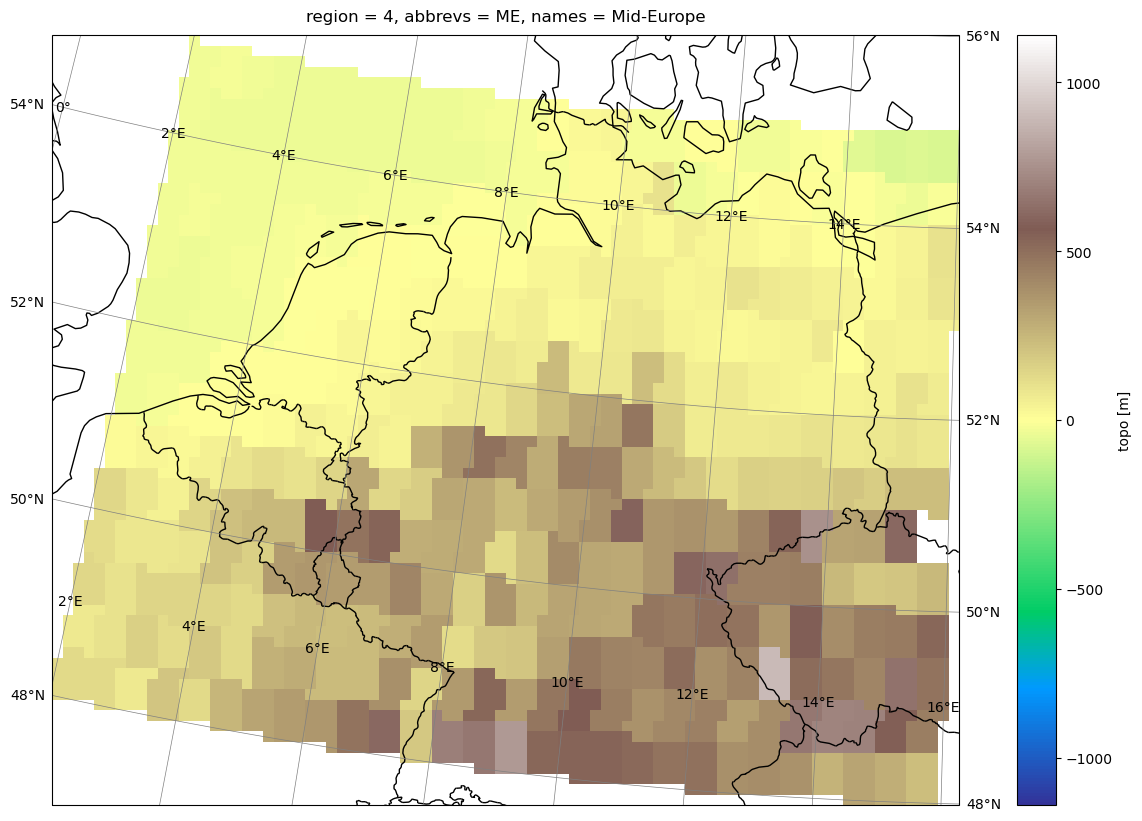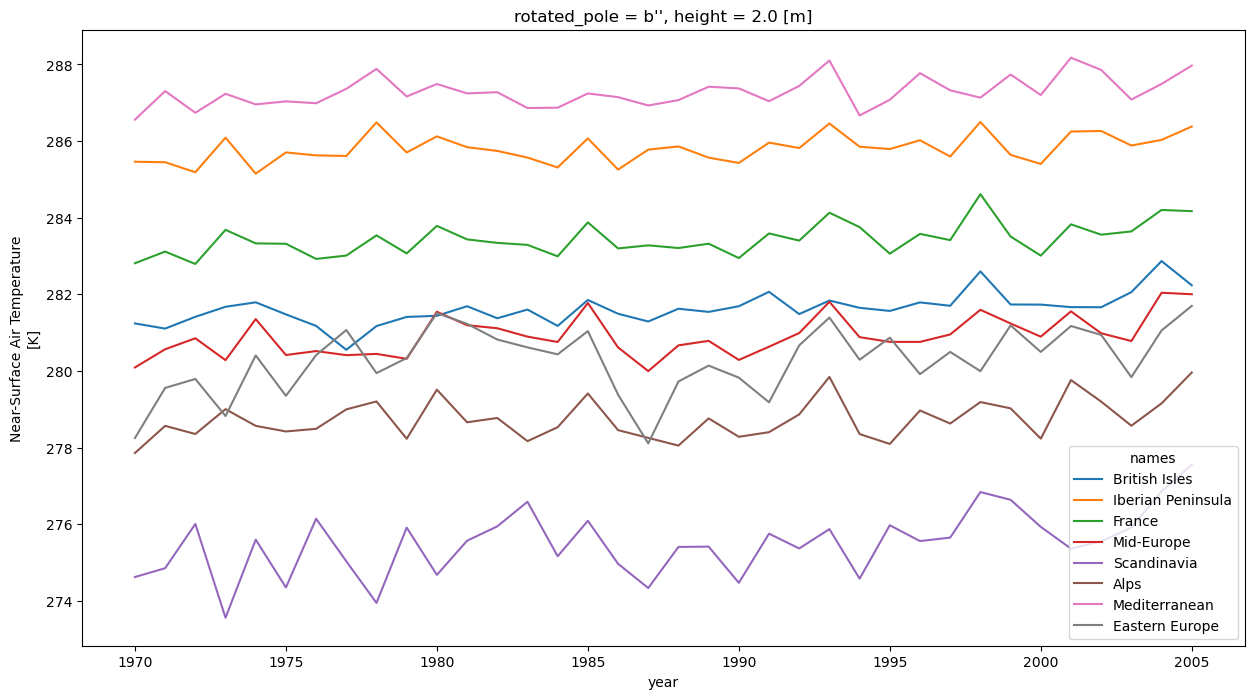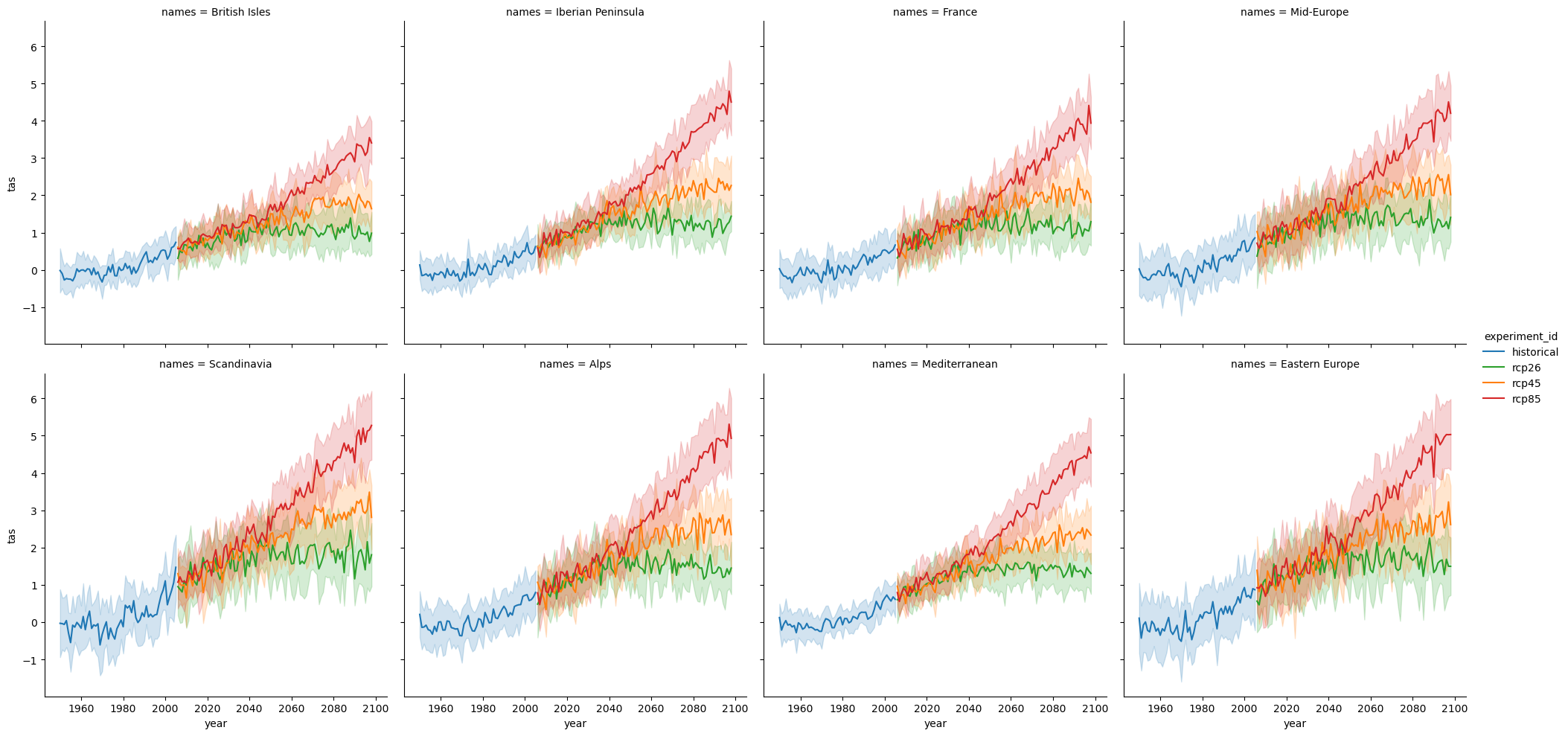Regional means#
This notebook should demonstrate how CORDEX datasets can be used for looking at regional scales. This often involves masking and averaging over a limited area of the dataset, e.g., a country or city.
import os
from collections import OrderedDict, defaultdict
import cf_xarray as cfxr
import cordex as cx
import dask
import fsspec
import intake
import matplotlib.pyplot as plt
import numpy as np
import regionmask
import tqdm
import xarray as xr
from cartopy import crs as ccrs
xr.set_options(keep_attrs=True)
<xarray.core.options.set_options at 0x7ffb30b150f0>
Let’s define a usefule plotting function that we can reuse for different projections and transformations.
import cartopy.crs as ccrs
def plot(
da,
transform=ccrs.PlateCarree(),
projection=ccrs.PlateCarree(),
vmin=None,
vmax=None,
cmap=None,
borders=True,
xlocs=range(-180, 180, 2),
ylocs=range(-90, 90, 2),
extent=None,
figsize=(15, 10),
title=None,
):
"""plot a domain using the right projections and transformations with cartopy"""
import cartopy.feature as cf
import matplotlib.pyplot as plt
plt.figure(figsize=figsize)
ax = plt.axes(projection=projection)
if extent:
# ax.set_extent([ds_sub.rlon.min(), ds_sub.rlon.max(), ds_sub.rlat.min(), ds_sub.rlat.max()], crs=transform)
ax.set_extent(extent, crs=projection)
ax.gridlines(
draw_labels=True, linewidth=0.5, color="gray", xlocs=xlocs, ylocs=ylocs
)
da.plot(ax=ax, cmap=cmap, transform=transform, vmin=vmin, vmax=vmax)
ax.coastlines(resolution="50m", color="black", linewidth=1)
if borders:
ax.add_feature(cf.BORDERS)
if title is not None:
ax.set_title(title)
Masking with regionmask#
We will use the python package regionmask to mask certain regions in the EURO-CORDEX domain and compute a mean for each region. This will give us a little more detailled regional information and how the warming depends on it. In this example, we will use the PRUDENCE regions (European sub-areas for regional climate model output) which are often used for European climate studies. The PRUDENCE regions are included in regionmask. Let’s have a look at them.
prudence = regionmask.defined_regions.prudence
prudence
<regionmask.Regions 'PRUDENCE'>
Source: Christensen and Christensen, 2007, Climatic Change 81:7-30 (https:/...
overlap: True
Regions:
1 BI British Isles
2 IP Iberian Peninsula
3 FR France
4 ME Mid-Europe
5 SC Scandinavia
6 AL Alps
7 MD Mediterranean
8 EA Eastern Europe
[8 regions]
Let’s have a look at those regions:
proj = ccrs.LambertConformal(central_longitude=10)
ax = prudence.plot(
add_ocean=True,
projection=proj,
resolution="50m",
label="name",
line_kws=dict(lw=0.75),
)

We can use these regions with regionmask to create masks for our gridded data. Let’s use some dummy topography data to show how the masking works.
ds = cx.cordex_domain("EUR-11", dummy="topo")
mask_prudence = prudence.mask_3D(ds.lon, ds.lat)
mask_prudence.plot(col="region")
<xarray.plot.facetgrid.FacetGrid at 0x7ffb30b15930>

mask_prudence
<xarray.DataArray 'mask' (region: 8, rlat: 412, rlon: 424)>
array([[[False, False, False, ..., False, False, False],
[False, False, False, ..., False, False, False],
[False, False, False, ..., False, False, False],
...,
[False, False, False, ..., False, False, False],
[False, False, False, ..., False, False, False],
[False, False, False, ..., False, False, False]],
[[False, False, False, ..., False, False, False],
[False, False, False, ..., False, False, False],
[False, False, False, ..., False, False, False],
...,
[False, False, False, ..., False, False, False],
[False, False, False, ..., False, False, False],
[False, False, False, ..., False, False, False]],
[[False, False, False, ..., False, False, False],
[False, False, False, ..., False, False, False],
[False, False, False, ..., False, False, False],
...,
...
...,
[False, False, False, ..., False, False, False],
[False, False, False, ..., False, False, False],
[False, False, False, ..., False, False, False]],
[[False, False, False, ..., False, False, False],
[False, False, False, ..., False, False, False],
[False, False, False, ..., False, False, False],
...,
[False, False, False, ..., False, False, False],
[False, False, False, ..., False, False, False],
[False, False, False, ..., False, False, False]],
[[False, False, False, ..., False, False, False],
[False, False, False, ..., False, False, False],
[False, False, False, ..., False, False, False],
...,
[False, False, False, ..., False, False, False],
[False, False, False, ..., False, False, False],
[False, False, False, ..., False, False, False]]])
Coordinates:
* rlon (rlon) float64 -28.38 -28.27 -28.16 -28.05 ... 17.93 18.05 18.16
* rlat (rlat) float64 -23.38 -23.27 -23.16 -23.05 ... 21.61 21.73 21.84
lon (rlat, rlon) float64 -10.06 -9.964 -9.864 ... 64.55 64.76 64.96
lat (rlat, rlon) float64 21.99 22.03 22.07 22.11 ... 66.81 66.75 66.69
* region (region) int64 1 2 3 4 5 6 7 8
abbrevs (region) <U2 'BI' 'IP' 'FR' 'ME' 'SC' 'AL' 'MD' 'EA'
names (region) <U17 'British Isles' ... 'Eastern Europe'
Attributes:
standard_name: regionWe can see that regionmask gives us a new dataset that contains a True/False mask for each region tailored to the grid of our datasets’s latitude and longitude coordinates. We can then easily use these masks with xr.where to make an analysis for each region, e.g., we can plot only topography for a certain region:
# get pole info for plotting
pole = (
ds.rotated_latitude_longitude.grid_north_pole_longitude,
ds.rotated_latitude_longitude.grid_north_pole_latitude,
)
# drop topography where mask if False
me_topo = ds.topo.where(
mask_prudence.isel(region=(mask_prudence.names == "Mid-Europe")).squeeze(),
drop=True,
)
# plot
plot(
me_topo,
transform=ccrs.RotatedPole(*pole),
projection=ccrs.RotatedPole(*pole),
cmap="terrain",
# figsize=(15,10)
)

Regional spatial average#
Let’s compute a spatial average over each region to compare the changes between them. We will start a dask client and open up some real datasets.
from dask.distributed import Client
client = Client()
client
Client
Client-2a5a646c-048a-11ee-9272-0a81f99f6e8d
| Connection method: Cluster object | Cluster type: distributed.LocalCluster |
| Dashboard: /user/larsbuntemeyer/proxy/8787/status |
Cluster Info
LocalCluster
a5b875a4
| Dashboard: /user/larsbuntemeyer/proxy/8787/status | Workers: 4 |
| Total threads: 16 | Total memory: 58.88 GiB |
| Status: running | Using processes: True |
Scheduler Info
Scheduler
Scheduler-d09c8ba5-0526-4f88-84c0-89f8d9e57e05
| Comm: tcp://127.0.0.1:33761 | Workers: 4 |
| Dashboard: /user/larsbuntemeyer/proxy/8787/status | Total threads: 16 |
| Started: Just now | Total memory: 58.88 GiB |
Workers
Worker: 0
| Comm: tcp://127.0.0.1:40325 | Total threads: 4 |
| Dashboard: /user/larsbuntemeyer/proxy/35443/status | Memory: 14.72 GiB |
| Nanny: tcp://127.0.0.1:44501 | |
| Local directory: /tmp/dask-worker-space/worker-cec0tpgq | |
Worker: 1
| Comm: tcp://127.0.0.1:36929 | Total threads: 4 |
| Dashboard: /user/larsbuntemeyer/proxy/44321/status | Memory: 14.72 GiB |
| Nanny: tcp://127.0.0.1:41641 | |
| Local directory: /tmp/dask-worker-space/worker-c74cqngp | |
Worker: 2
| Comm: tcp://127.0.0.1:33951 | Total threads: 4 |
| Dashboard: /user/larsbuntemeyer/proxy/39311/status | Memory: 14.72 GiB |
| Nanny: tcp://127.0.0.1:46355 | |
| Local directory: /tmp/dask-worker-space/worker-0fbjvynt | |
Worker: 3
| Comm: tcp://127.0.0.1:39777 | Total threads: 4 |
| Dashboard: /user/larsbuntemeyer/proxy/46775/status | Memory: 14.72 GiB |
| Nanny: tcp://127.0.0.1:33289 | |
| Local directory: /tmp/dask-worker-space/worker-q080ufic | |
We open our ESM collection on AWS S3 and load all air temperature datasets into a dataset dictionary.
url = "https://euro-cordex.s3.eu-central-1.amazonaws.com/catalog/CORDEX-CMIP5.json"
cat = intake.open_esm_datastore(url)
subset = cat.search(
variable_id="tas",
experiment_id=["historical", "rcp26", "rcp45", "rcp85"],
# driving_model_id = ["MPI-M-MPI-ESM-LR", 'IPSL-IPSL-CM5A-LR']
)
dsets = subset.to_dataset_dict(
xarray_open_kwargs={"consolidated": True, "decode_times": True, "use_cftime": True},
storage_options={"anon": True},
)
--> The keys in the returned dictionary of datasets are constructed as follows:
'project_id.CORDEX_domain.institute_id.driving_model_id.experiment_id.member.model_id.rcm_version_id.frequency'
Sorting by experiment:
def sort_datasets(dsets):
results = defaultdict(dict)
for dset_id, ds in tqdm.tqdm(dsets.items()):
exp_id = dset_id.split(".")[4]
new_id = dset_id.replace(f"{exp_id}.", "")
if exp_id != "historical":
ds = ds.sel(time=slice("2006", "2100"))
else:
ds = ds.sel(time=slice("1950", "2005"))
results[exp_id][new_id] = ds
return OrderedDict(sorted(results.items()))
dsets_sorted = sort_datasets(dsets)
100%|██████████| 186/186 [00:00<00:00, 425.14it/s]
Here, we define our actual analysis. We compute a yearly mean for each prudence region by using regionmask’s masking feature together with xarray’s weighted mean.
def weighted_mean(ds):
"""Compute a weighted spatial mean using regionmask"""
mask = prudence.mask_3D(ds.cf["longitude"], ds.cf["latitude"])
# mask = mask_prudence#.assign_coords(region=mask_prudence.names)
return ds.cf.weighted(mask).mean(dim=("X", "Y"))
def yearly_regional_mean(ds):
"""compute yearly mean for one dataset"""
return weighted_mean(ds).groupby("time.year").mean()
def ensemble_mean(dsets):
"""compute ensemble yearly mean"""
return xr.concat(
[yearly_regional_mean(ds.cf["tas"]) for ds in dsets.values()],
dim=xr.DataArray(list(dsets.keys()), dims="dset_id"),
coords="minimal",
compat="override",
)
Let’s check this out for one dataset before we compute it for the entire ensemble.
mean = yearly_regional_mean(list(dsets_sorted["historical"].values())[10].cf["tas"])
mean
<xarray.DataArray 'tas' (year: 36, region: 8)>
dask.array<transpose, shape=(36, 8), dtype=float64, chunksize=(23, 8), chunktype=numpy.ndarray>
Coordinates:
rotated_pole |S1 b''
height float64 2.0
* region (region) int64 1 2 3 4 5 6 7 8
names (region) <U17 'British Isles' ... 'Eastern Europe'
abbrevs (region) <U2 'BI' 'IP' 'FR' 'ME' 'SC' 'AL' 'MD' 'EA'
* year (year) int64 1970 1971 1972 1973 1974 ... 2002 2003 2004 2005
Attributes:
cell_methods: time: mean
grid_mapping: rotated_pole
long_name: Near-Surface Air Temperature
standard_name: air_temperature
units: KWe can see that, in fact, we get a timeseries of yearly mean for each PRUDENCE region. The datasets contains an additional region coordinate that we can use for plotting:
mean.swap_dims(region="names").plot(hue="names", figsize=(15, 8))
[<matplotlib.lines.Line2D at 0x7ff9d9b151b0>,
<matplotlib.lines.Line2D at 0x7ffa2ae84a00>,
<matplotlib.lines.Line2D at 0x7ffa2aeec220>,
<matplotlib.lines.Line2D at 0x7ffa2b0351e0>,
<matplotlib.lines.Line2D at 0x7ff9d9b549d0>,
<matplotlib.lines.Line2D at 0x7ff9d9b54310>,
<matplotlib.lines.Line2D at 0x7ffa09bd0160>,
<matplotlib.lines.Line2D at 0x7ffa09bd0100>]

Now, let’s trigger the heavy computation for the entire ensemble.
%time ensembles = {exp_id: ensemble_mean(dsets).compute() for exp_id, dsets in dsets_sorted.items()}
CPU times: user 3min, sys: 15.2 s, total: 3min 15s
Wall time: 12min 34s
ensembles.keys()
dict_keys(['historical', 'rcp26', 'rcp45', 'rcp85'])
ensemble = xr.concat(
list(ensembles.values()),
dim=xr.DataArray(list(ensembles.keys()), dims="experiment_id"),
coords="minimal",
compat="override",
)
dset_id = ensemble.where(ensemble < 100.0, drop=True).dset_id
ensemble.loc[dict(dset_id=dset_id)] = ensemble.sel(dset_id=dset_id) + 273.5
ensemble.to_netcdf("prudence-tas-ensemble.nc")
ensemble
<xarray.DataArray 'tas' (experiment_id: 4, dset_id: 74, year: 151, region: 8)>
array([[[[ nan, nan, nan, ..., nan,
nan, nan],
[ nan, nan, nan, ..., nan,
nan, nan],
[ nan, nan, nan, ..., nan,
nan, nan],
...,
[ nan, nan, nan, ..., nan,
nan, nan],
[ nan, nan, nan, ..., nan,
nan, nan],
[ nan, nan, nan, ..., nan,
nan, nan]],
[[282.2107418 , 286.93128853, 284.63980798, ..., 281.63338982,
288.77574783, 282.50199637],
[282.53776467, 287.46103499, 285.28139925, ..., 282.05806444,
288.82877696, 282.73484321],
[282.31529086, 287.21012818, 284.82111491, ..., 281.96693104,
289.23218221, 282.94636519],
...
[286.1495131 , 290.91816237, 288.58114999, ..., 284.33248825,
291.9262367 , 285.63031609],
[285.28652941, 291.09695127, 288.43458272, ..., 285.10354076,
292.37664367, 285.7401946 ],
[285.56761724, 291.20473895, 288.80000154, ..., 285.67128525,
292.73072402, 286.76624824]],
[[ nan, nan, nan, ..., nan,
nan, nan],
[ nan, nan, nan, ..., nan,
nan, nan],
[ nan, nan, nan, ..., nan,
nan, nan],
...,
[284.3824196 , 290.56766683, 286.35423898, ..., 284.57922993,
292.12598988, 284.89635763],
[284.25291498, 290.10685423, 286.44420236, ..., 284.88520879,
292.44595895, 285.00371295],
[284.48374536, 290.85452062, 286.54731044, ..., 284.71317561,
292.02362115, 284.41440815]]]])
Coordinates:
* region (region) int64 1 2 3 4 5 6 7 8
* year (year) int64 1950 1951 1952 ... 2098 2099 2100
* dset_id (dset_id) <U78 'cordex-reklies.EUR-11.CLMcom-...
rotated_latitude_longitude int32 -2147483647
Lambert_Conformal |S1 b''
crs |S1 b''
rotated_pole |S1 b''
height float64 2.0
names (region) <U17 'British Isles' ... 'Eastern Eu...
abbrevs (region) <U2 'BI' 'IP' 'FR' ... 'AL' 'MD' 'EA'
* experiment_id (experiment_id) <U10 'historical' ... 'rcp85'
Attributes:
cell_methods: time: mean
grid_mapping: rotated_pole
long_name: Near-Surface Air Temperature
standard_name: air_temperature
units: KAgain, we will look at the change in temperature which is more interesting.
change = ensemble - ensemble.sel(
experiment_id="historical", year=slice(1961, 1990)
).mean("year")
df = change.to_dataframe().reset_index()[
["year", "experiment_id", "dset_id", "names", "tas"]
]
df
| year | experiment_id | dset_id | names | tas | |
|---|---|---|---|---|---|
| 0 | 1950 | historical | cordex-reklies.EUR-11.CLMcom-BTU.MPI-M-MPI-ESM... | British Isles | NaN |
| 1 | 1950 | historical | cordex-reklies.EUR-11.CLMcom-BTU.MPI-M-MPI-ESM... | Iberian Peninsula | NaN |
| 2 | 1950 | historical | cordex-reklies.EUR-11.CLMcom-BTU.MPI-M-MPI-ESM... | France | NaN |
| 3 | 1950 | historical | cordex-reklies.EUR-11.CLMcom-BTU.MPI-M-MPI-ESM... | Mid-Europe | NaN |
| 4 | 1950 | historical | cordex-reklies.EUR-11.CLMcom-BTU.MPI-M-MPI-ESM... | Scandinavia | NaN |
| ... | ... | ... | ... | ... | ... |
| 357563 | 2100 | rcp85 | cordex.EUR-11.UHOH.MPI-M-MPI-ESM-LR.r1i1p1.WRF... | Mid-Europe | NaN |
| 357564 | 2100 | rcp85 | cordex.EUR-11.UHOH.MPI-M-MPI-ESM-LR.r1i1p1.WRF... | Scandinavia | NaN |
| 357565 | 2100 | rcp85 | cordex.EUR-11.UHOH.MPI-M-MPI-ESM-LR.r1i1p1.WRF... | Alps | NaN |
| 357566 | 2100 | rcp85 | cordex.EUR-11.UHOH.MPI-M-MPI-ESM-LR.r1i1p1.WRF... | Mediterranean | NaN |
| 357567 | 2100 | rcp85 | cordex.EUR-11.UHOH.MPI-M-MPI-ESM-LR.r1i1p1.WRF... | Eastern Europe | NaN |
357568 rows × 5 columns
import seaborn as sns
palette = {"historical": "C0", "rcp26": "C2", "rcp45": "C1", "rcp85": "C3"}
g = sns.relplot(
data=df[(df["year"] >= 1950) & (df["year"] <= 2098)],
x="year",
y="tas",
hue="experiment_id",
kind="line",
# errorbar=("ci", 95),
errorbar="sd",
# aspect=2,
palette=palette,
col="names",
col_wrap=4,
)
# g.set(title="Yearly model mean with 95th percentile confidence interval")


